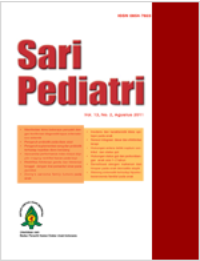Infeksi pada Ginjal dan Saluran Kemih Anak: Manifestasi Klinis dan Tata Laksana
Sari
Infeksi saluran kemih (ISK) disebabkan berbagai jenis mikroba seperti bakteri, virus, dan jamur. Penyebab ISK paling sering adalah bakteri Escherichia coli. Infeksi saluran kemih pada anak dapat diklasifikasikan berdasarkan lokasi infeksi, manifestasi klinis, ada tidaknya kelainan saluran kemih, dan kepentingan klinis. Manifestasi klinis ISK bervariasi, tergantung pada usia, tempat infeksi dalam saluran kemih, dan beratnya infeksi atau intensitas reaksi peradangan. Sebagian ISK pada anak merupakan ISK asimtomatik dan umumnya ditemukan pada anak usia sekolah, terutama anak perempuan dan ISK asimtomatik umumnya tidak berlanjut menjadi pielonefritis. Manifestasi klinis ISK pada anak dapat berupa pielonefritis akut atau febrile urinary tract infection, sistitis, sistitis hemorhagik, ISK asimtomatik. Tata laksana ISK terdiri atas eradikasi infeksi akut, deteksi dan tata laksana kelainan anatomi dan fungsional pada ginjal dan saluran kemih, deteksi dan mencegah infeksi berulang. Tujuan pemberian antimikroba adalah untuk mengatasi infeksi akut, mencegah urosepsis, dan mencegah atau mengurangi kerusakan ginjal.
Kata Kunci
Teks Lengkap:
PDFReferensi
Jantausch B, Kher K. Urinary tract infection. Dalam: Kher KK, Schnaper HW, Makker SP, penyunting, Clinical Pediatric Nephrology, edisi ke-2, London, Informa Health Care, 2007;h. 553-73.
Hodson EM, Craig JC. Urinary tract infection in children. Dalam: Avner ED, Harmon WE, Niaudet P, Yoshikawa B, Emma F, Goldstein SL, penyunting, Pediatric Nephrology, edisi ke-7, New York, Springer Reference, 2016;h.1696-714,
Goldberg B, Jantausch B. Urinary tract infection. Dalam: Kher KK, Schnaper HM, Breenbaum LA, penyunting. Clinical Pediatric Nephrology, edisi ke-3, CRC PRESS, New York, 2017;h.967-91.
Hari P, Srivastava RN. Urinary tract infection. Dalam: Srivastava RN, Bagga A, penyunting. Pediatric Nehrology, edisi ke-empat, New Delhi-London, Jaypee Brothers Medical Publisher, 2011,h.273-300.
Yilmaz A, Sevketoglu E, Gedikbasi A, Karyagar S, Kiyak A, Mulazimoglu M, dkk. Early prediction of urinary tract infection with urinary neutrophil gelatinase associated lipocalin. Pediatr Nephrol 2009;24:2387-92.
Jodal U. Urinary tract infection: Significance, pathogenesis, clinical features and diagnosis. Dalam: Postlethwaite RJ, penyunting, Clinical Paediatr Nephrology, edisi ke-2, Oxford, Butterworth-Heinemann, 1994;h.151-9.
Lambert H, Coultard M. The child with urinary tract infection. Dalam: Webb NJA, Postlethwaite RJ, penyunting, Clinical Paediatric Nephrology, edisi ke-3, Oxford, Oxford University Press, 2003,h.197-225.
Pardede SO, Tambunan T, Alatas H, Trihono PP, Hidayati EL.. Konsensus Infeksi Saluran Kemih pada Anak. UKK Nefrologi IDAI, Badan Penerbit IDAI, Jakarta, 2011.
Smolkin V, Koren A, Raz R, Colodner R, Sakran W, Halevy R. Procalcitonin as a marker of acute pyelonephritis in infants and children. Pediatr Nephrol 2002;17:409-12.
Gurgoze MK, Akarsu S, Yilmaz E, Godekmerdan A, Akca Z, Ciftci I, Ayugin AD. Proinflamatory cytokines and procalcitonin in children with acute pyelonephritis. Pediatr Nephrol 2005;20:1445-8.
Roberts KB. Urinary tract infection. Clinical practice guideline fos the diagnosis and management of the initial UTI in febrile infants and children 2-24 months,. Pediatrics.2011;128:595-610.
Bagga A, Gulati A. Disease of the newborn. Dalam: Srivastava RN, Bagga A, penyunting. Pediatric Nehrology, edisi ke-empat, New Delhi-London, Jaypee Brothers Medical Publisher, 2011,p.494-524.
Bensman A, Dunand O, Ulinski T. Urinary tract infection. Dalam: Avner ED, Harmon WE, Niaudet P, Yoshikawa N, penyunting. Pediatric Nephrology, edisi ke-6, Springer-Verlag, Berlin Heidelberg, 2009,h.1229-310.
Shet A. The kidney and the tropics. Dalam: Phadke K, Goodyer P, Bitzan M, penyunting. Manual of Pediatric Nephrology. London, Springer, 2014.h. 461-77.
Bloomfield P, Hodson EM, Craig JC. Antibiotics for acute pyelonephritis in children. Cochrane Database Syst Rev 2005; CD003772.
Hoberman A,Wald ER, Hickey RW, Baskin M, Charron M, Majd M, Kearney DH, Reynolds EA, Ruley J, Janosky JE. Oral versus initial intravenous therapy for urinary tract infections in young febrile children. Pediatrics 1999;104:79–86.
Montini G, Toffolo A, Zucchetta P, Dall’Amico R, Gobber D, Calderan A, dkk. Antibiotic treatment for pyelonephritis in children: multicentre randomised controlled non-inferiority trial. Br Med J. 2007;335:386.
Brandstrom P, Hansson S. Long-term, low-doe prophylaxis gainst urinary tract infection in young children. Pediatr Nephrol.2015;30:425-32.
Lee SJ, Shim YH, Cho SJ, Lee JW. Probiotics prophylaxis in children with persistent primary vesicoureteral reflux. Pediatr Nephrol 2007;22:1315-20.
DOI: http://dx.doi.org/10.14238/sp19.6.2018.364-74
Refbacks
- Saat ini tidak ada refbacks.
##submission.copyrightStatement##
##submission.license.cc.by-nc-sa4.footer##
Email: editorial [at] saripediatri.org


Sari Pediatri diterbitkan oleh Badan Penerbit Ikatan Dokter Anak Indonesia
Ciptaan disebarluaskan di bawah Lisensi Creative Commons Atribusi-NonKomersial-BerbagiSerupa 4.0 Internasional.




